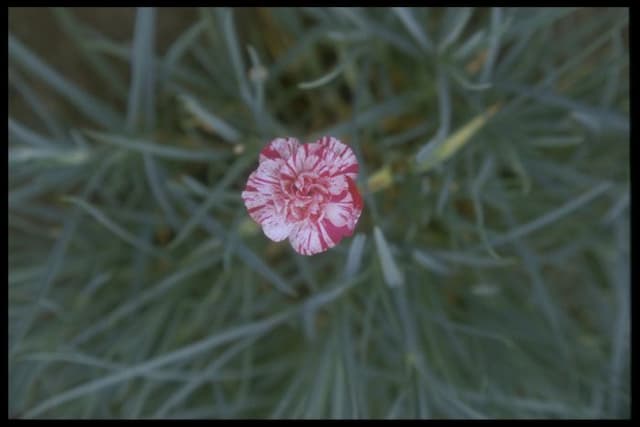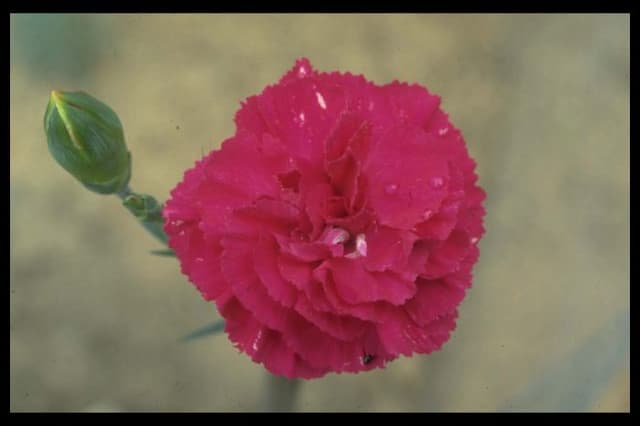Carnation Dianthus Coconut Sundae = 'Wp 05 Yves' (PBR) (Scent First Series) (p)
![pink [Coconut Sundae]](/_next/image?url=https%3A%2F%2Fplants-admin.emdemapps.com%2Fimages%2Fplants%2F%2Fimages%2F604b5d09d4fd1.png&w=3840&q=75)
ABOUT
The Dianthus Coconut Sundae is a delightful plant known for its striking appearance and pleasant fragrance. This variety often features beautifully ruffled blooms that boast a unique coloration: the petals are predominantly white but are dramatically contrasted by a burst of rich, raspberry-pink at the base, creating the impression of a dainty floral sundae. The bright colors make the flowers stand out in any garden setting. The blooms of the Dianthus Coconut Sundae are particularly noted for their strong, sweet scent that is reminiscent of coconut, which can waft through the air and enhance the sensory experience of a garden. Each flower consists of several layers of petals, and the edges of these petals may be finely serrated or fringed, adding to the plant's decorative appeal. Aside from its stunning flowers, the plant also has a neat, compact growth habit, forming a cushion or tuft of narrow, lance-shaped leaves. The foliage tends to be blue-green to gray-green in color, providing an attractive backdrop for the vibrant flowers. The overall effect of the plant's appearance is one that is both eye-catching and charming, making it a popular choice for gardeners wishing to add a splash of color and fragrance to their outdoor spaces.
About this plant
 Names
NamesSynonyms
Coconut Sundae Dianthus, Coconut Sundae Carnation, Coconut Sundae Pink
Common names
Dianthus 'Wp 05 Yves'
 Toxicity
ToxicityTo humans
Carnation is not considered toxic to humans. Generally, the ingestion of any part of this plant does not lead to serious poisoning. However, individual sensitivities vary, and eating ornamental plants is not advised.
To pets
Carnation is also not considered toxic to pets. The plant is generally safe and ingestion typically does not cause serious harm. However, as with humans, pets may vary in their sensitivity, and consuming any part of the plant could potentially lead to gastrointestinal upset or other mild reactions in some animals.
 Characteristics
CharacteristicsLife cycle
Perennials
Foliage type
Evergreen
Color of leaves
Blue-green
Flower color
White
Height
1 foot 2 feet (30-60 cm)
Spread
1 foot 1 foot (30-30 cm)
Plant type
Herb
Hardiness zones
5
Native area
Europe
Benefits
 General Benefits
General Benefits- Aesthetic Appeal: Dianthus Coconut Sundae adds vibrant color and texture to gardens with its attractive pink and white patterned petals.
- Fragrance: The flowers emit a pleasant spicy fragrance which can enhance the sensory experience in a garden or indoor setting.
- Pollinator Friendly: The blooms attract beneficial pollinators such as bees and butterflies, supporting local ecosystems.
- Easy to Grow: This variety of dianthus is known for being hardy and relatively easy to care for, making it suitable for gardeners of all levels.
- Long Bloom Time: The plant has a long flowering season, providing color and interest in the garden from late spring to early fall.
- Versatility: Compact size and attractive mounding habit make Dianthus Coconut Sundae suitable for borders, rock gardens, and container gardening.
- Drought Tolerance: Once established, it shows a good level of drought resistance, which is beneficial in areas with water restrictions or for low-maintenance gardens.
- Cold Hardiness: It is resistant to cold temperatures, making it a good choice for gardens in cooler climates.
 Medical Properties
Medical PropertiesThis plant is not used for medical purposes.
 Air-purifying Qualities
Air-purifying QualitiesThis plant is not specifically known for air purifying qualities.
 Other Uses
Other Uses- Culinary Garnish: The petals of the Dianthus, commonly known as Carnation, can be used to add color and a mild spicy flavor to salads or desserts.
- Crafts and Potpourri: Dried Carnation petals can be incorporated into potpourri mixes for a long-lasting fragrance or used in various craft projects such as handmade paper or bookmarks.
- Floral Water: Carnation petals can be steeped in water to create a lightly scented floral water for use in homemade cosmetics or room sprays.
- Cake Decoration: Edible Carnation petals can be crystallized with egg whites and sugar to create elegant decorations for cakes and pastries.
- Natural Dye: The bright colored petals of Carnations can be used to create natural dyes for fabric, yarn, or paper.
- Perfumery: Carnation's distinct fragrance can be captured through enfleurage or distillation to contribute to custom perfume blends.
- Plant Markers: Dried Carnation stems can be repurposed as natural, biodegradable plant markers in the garden.
- Floral Arrangements: Carnations provide structure and a sweet fragrance to floral arrangements, and can even be dyed to match specific color schemes.
- Greeting Cards: Pressed Carnation flowers or petals can be used to embellish homemade greeting cards or scrapbook pages.
- Bath Additive: Carnation petals can be added to bath bombs or bath salts for an aromatic and colorful bathing experience.
Interesting Facts
 Feng Shui
Feng ShuiThe plant Carnation is not used in Feng Shui practice.
 Zodiac Sign Compitability
Zodiac Sign CompitabilityThe plant Carnation is not used in astrology practice.
 Plant Symbolism
Plant Symbolism- Love: Dianthus is often associated with love, particularly a lover's affection, due to its history in mythology and beautiful flowering nature.
- Admiration: The vivid colors and sweet fragrance of Dianthus can symbolize admiration, making it a popular gift to show respect and high esteem for someone.
- Purity: Dianthus, with its clear white or light-hued petals, is frequently related to purity and the Virgin Mary in Christian symbolism.
- Boldness: The bright and striking appearance of Dianthus signifies boldness and challenging the norms, reflecting the flower's resilient character.
- Divine Love: Due to its long-standing religious associations, Dianthus can represent divine or heavenly love, signifying an eternal and spiritual connection.
- Protection: In folk traditions, Dianthus was believed to hold protective properties, and it was used to ward off evil spirits or misfortune.
 Water
WaterThe Dianthus 'Coconut Sundae' prefers consistent moisture but does not do well in waterlogged soil. Water the plant when the top inch of soil feels dry to the touch, which generally means watering once or twice a week, depending on weather conditions and soil drainage. Use about a gallon per plant per watering session to ensure even moisture is delivered to the root zone. During hot spells or in particularly dry regions, you may need to water more frequently, while in cooler or rainy periods, less frequent watering is required. Over-watering can lead to root rot, so it’s crucial to ensure good drainage.
 Light
LightThe Dianthus 'Coconut Sundae' thrives in full sun conditions where it can receive 6 to 8 hours of direct sunlight daily. A south-facing garden spot is ideal for this plant to flourish and produce an abundance of its fragrant flowers. In regions with particularly strong afternoon sun, a location that offers some light afternoon shade can help prevent potential scorched foliage.
 Temperature
TemperatureDianthus 'Coconut Sundae' does well in a typical garden range of temperatures but prefers cooler conditions. It can survive temperatures as low as 20 degrees Fahrenheit and as high as 85 degrees Fahrenheit. The ideal growing conditions for Dianthus 'Coconut Sundae' would be in temperatures ranging from 60 to 70 degrees Fahrenheit, where it can grow and flourish without stress.
 Pruning
PruningPruning Dianthus 'Coconut Sundae' is done to remove spent flowers and encourage a second flush of blooms, to shape the plant, and to promote vigorous growth. Deadheading, the process of removing faded flowers, should occur regularly throughout the blooming season. More extensive pruning to remove woody stems or to shape the plant is best done in early spring or after the main flowering has finished.
 Cleaning
CleaningAs needed
 Soil
SoilThe Dianthus 'Coconut Sundae', commonly known as Pinks, thrives best in well-drained, loamy or sandy soil with a neutral to slightly alkaline pH of 6.5 to 7.5. A mix incorporating compost or well-rotted manure will enhance drainage and fertility.
 Repotting
RepottingPinks should be repotted every 2 to 3 years to replenish soil nutrients and prevent crowding. Spring or autumn is the ideal time for repotting these perennials.
 Humidity & Misting
Humidity & MistingPinks prefer moderate humidity levels, but they are quite tolerant of different humidity conditions as long as good air circulation is provided and the soil drainage is adequate.
 Suitable locations
Suitable locationsIndoor
Ensure bright light, well-draining soil, and infrequent watering for indoor Pinks.
Outdoor
Plant in full sun, well-draining soil, and space for adequate air flow.
Hardiness zone
4-9 USDA
 Life cycle
Life cycleThe life of a Dianthus Coconut Sundae, commonly known as Pink, begins with seed germination, typically in late winter to early spring under the right temperature and moisture conditions. The seedlings then develop into young plants with a rosette of leaves at ground level, and as they mature, they produce sturdy stems with denary, opposite, narrow leaves. During the blooming stage in late spring to early summer, Pinks produce fragrant, showy, double flowers with ruffled petals that are attractive to pollinators. After pollination, seeds develop in capsules and are eventually dispersed, completing the reproductive cycle. The Pinks undergo a period of dormancy during the winter, where they exhibit little to no growth. This perennial plant can live for several years, producing flowers annually, and may be propagated by cuttings or division to maintain or increase stocks.
 Propogation
PropogationPropogation time
Spring-Early Summer
Dianthus Coconut Sundae, also known as 'Coconut Sundae', is most commonly propagated through cuttings. To propagate by cuttings, select healthy, non-flowering stems from the plant in late spring to early summer. Cut a stem 4 to 6 inches (10 to 15 centimeters) long just below a leaf node, remove the lower leaves, and dip the cut end into a rooting hormone powder. Insert the stem in a pot filled with a well-draining, sterile soil mix. Water the soil and cover the pot with a plastic bag to maintain humidity. Place the pot in indirect light and keep the soil consistently moist. Roots typically develop in 2 to 3 weeks, after which you can remove the plastic and gradually acclimatize the new plant to outdoor conditions before planting it out.









